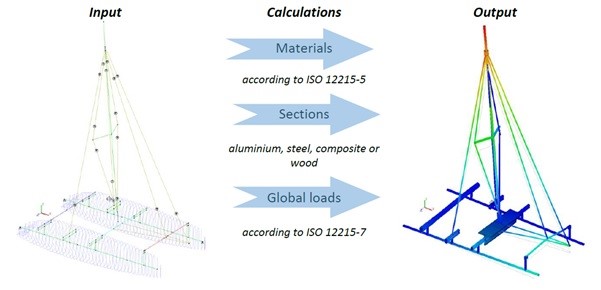Multihull Global Load Calculations According to ISO 12215-7
Part 7 of ISO 12215 was finalised at the end of 2019. Besides the determination of loads, it provides calculations for the assessment of Global Loads for Multihulls.
The standard offers a simplified method, mostly to be used for cruising catamarans, as well as an enhanced method which provides more accurate analysis and results and which is applicable to any structural arrangement.
Overview of Global Loads:
- Quartering sea
- Rig load
- Asymmetric broaching
- Longitudinal broaching / pitchpoling
- Longitudinal force/shock
- Bending on crossbeams of motor multihulls
For typical structure arrangements (multihulls with a significant wet deck), you can use the simplified method. According to the standard, you must check the global structure against the greater of the following two load cases:
- Combination of 100% Quartering sea + 50% Rig load or
- Combination of 50% Quartering sea +100% Rig load
We have developed a structural assessment method by making use of the following software packages:
- Hullscant Software:
for the determination of the materials and beam section properties in all kind of materials (including GRP and Carbon).
- Multiframe Software:
for the Global Load structural assessment.
FEA beam analysis software has been chosen in order to keep the calculations within budget. In case detailed FAE analysis is required this can be offered in cooperation with our partner.
On request, calculations can be extended with global mast and rig assessments according to the requirements of ISO/FDIS 12215-10 rig loads and rig attachment in sailing yachts.
For questions regarding the ISO 12215-7 calculations, please contact us.
GET IN TOUCH
WIJMA MARINE CONSULTANTS
Jelmer Wijma
Contact Details
The Netherlands
VAT nr. NL002064132B34
Chambre of Commerce Nr. 37141529
General Conditions (English)
Algemene Voorwaarden (Dutch)
Privacy Statement (English)
Privacy Verklaring (Dutch)


